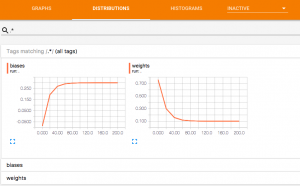import tensorflow as tf
import numpy as np
# create data
x_data = np.random.rand(100).astype(np.float32)
y_data = x_data*0.1 + 0.3
Weights = tf.Variable(tf.random_uniform([1], -1.0, 1.0))
tf.summary.histogram(‘weights’,Weights)
biases = tf.Variable(tf.zeros([1]))
tf.summary.histogram(‘biases’,biases)
y = Weights*x_data + biases
loss = tf.reduce_mean(tf.square(y-y_data))
optimizer = tf.train.GradientDescentOptimizer(0.5)
train = optimizer.minimize(loss)
init = tf.global_variables_initializer()
sess = tf.Session()
merged = tf.summary.merge_all()
writer = tf.summary.FileWriter(“logs/”,sess.graph)
sess.run(init)
for step in range(201):
sess.run(train)
if step % 20 == 0:
rs = sess.run(merged)
writer.add_summary(rs,step)
# print(step, sess.run(Weights), sess.run(biases), sess.run(loss))
可視化したい情報をtf.summary.histogram(‘グラフィック名’,変数名)に追加する。
このファイルのpathは~/Document/tensorflow/tensorboard.py、そして、実行の結果は~/Document/tensorflow/logsフォルダーに保存する。
次はターミナルを起動して
$cd ~/Document/tensorflow
$tensorboard –logdir logs
表示するurlをブラウザにコピー貼り付けて完了
*urlは127.0.0.1:6006にしても大丈夫だと思う

